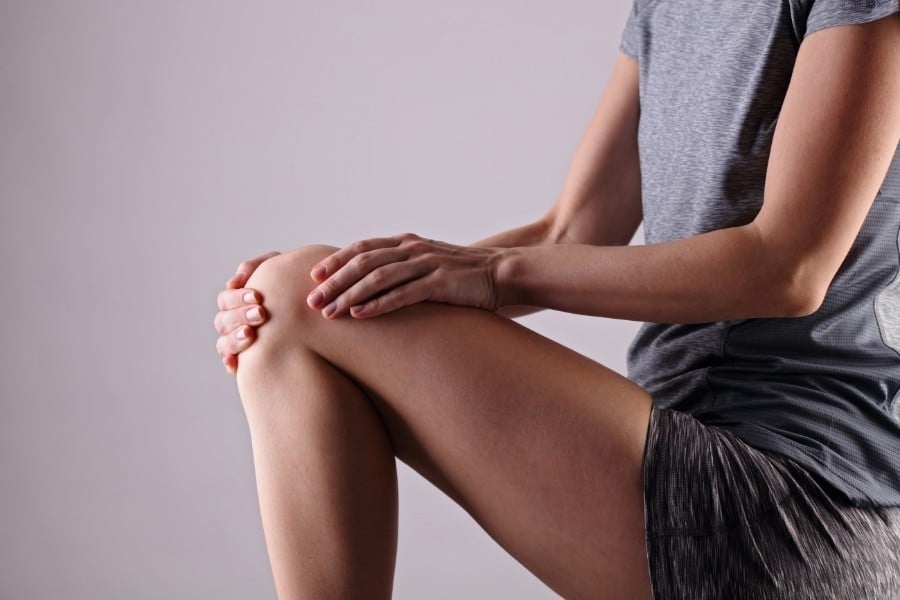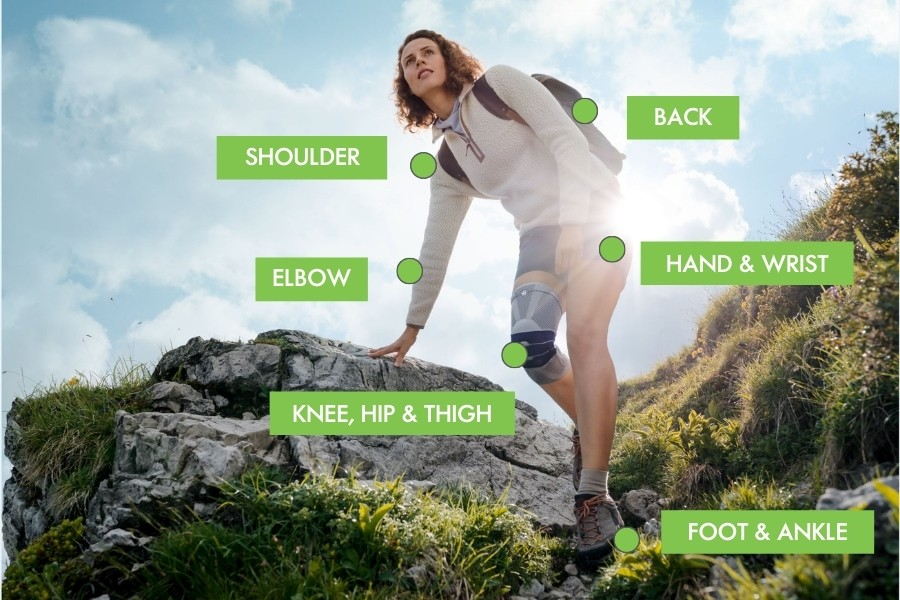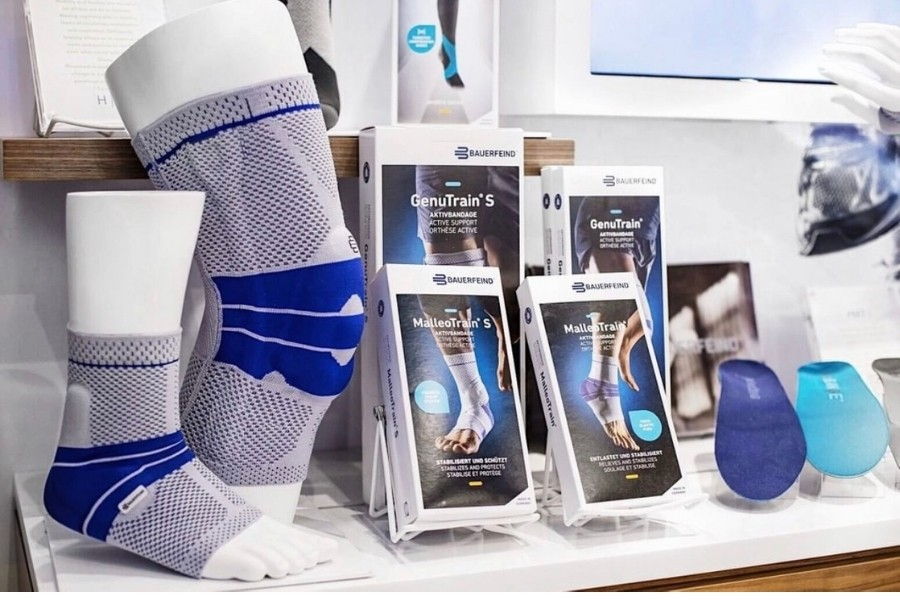Our bodies do a lot for us. With every step, head nod, walk down the block or swipe on our phone, there’s a lot more going on than what our eyes can see.
You likely know the basics about your muscles, bones, and body parts. But how much do you know about your joints?

Joints play a big role in your body’s ability to move and function since they act as the “cushioning” between bones. This is why experiencing joint pain – like in the knees, shoulders, or hips and to name a few – can be such an unpleasant health burden to deal with.
Simple everyday tasks can become a lot more challenging when you’re experiencing pain. Your morning walk might be a lot less peaceful if it’s disrupted by knee pain. Checking items off your to-do might feel less than satisfying when your wrist is painful or swollen. This is why supporting your body’s functionality is one of the best ways to avoid injury and maintain mobility throughout your life.
Noelle Rossi, our Kinesiologist, works specifically with patients at our clinic to improve their mobility. She takes a client-centered approach to injury recovery and quality of life improvement. This makes her an expert on the topic of joint health.
We teamed up with Noelle to learn more about joint pain and her suggestions for treating it effectively.
Joints: A Basic Breakdown
Before we explore how to manage your pain, what exactly are joints, and why are they important?
“Joints are essentially responsible for all our movement and stability in our body,” says Noelle. “They take the impact of our body weight which allows us to move. It’s really important because they ensure that we can be functional and healthy.”
Specifically, joints act as the connecting points between bones. There are three main types: diarthrosis, amphiarthroses, and synarthroses. They are defined by the type of movement they allow.
Diarthroses joints have a free range of movement. They’re also usually where people develop pain. There are six types of them that have their own unique ways of moving.
- Ball and socket (shoulder, hip)
- Hinge (elbow, knee)
- Condyloid (finger, jaw)
- Pivot (ulna and radius bones in your forearm)
- Gliding (wrist)
- Saddle (base of the thumb)
But the diarthrosis joints don’t do their job alone. There are two types of smooth tissue called cartilage and synovium that provide cushioning around your joints.
In addition, the synovial fluid helps to prevent the bones from rubbing together. They allow your body parts to have a full range of motion.
Based on how much goes on within your joints, it’s clear that it’s important for them to function properly. Being able to move freely and without pain is an integral part of inspired living.
“If we can’t move, we won’t be healthy physically or mentally. So, it’s really important that we’re able to move in the first place. That’s what our joints allow.”

What Causes Joint Pain?
Injuries are one of the main causes of joint pain. They can happen to people of all ages and activity levels. You may develop an injury from being in an accident, or from sports or exercise.
Regardless of how it developed, you should always seek proper treatment and care to avoid it getting worse. Injuries that cause joint pain typically fall under one of two types: sprains and strains.
It’s easy to get them confused because of their shared symptoms. This often includes pain around the joint, swelling, reduced flexibility, and an inability to have a full range of motion in that area.
The difference is that a sprain affects your ligaments, whereas a strain affects your muscles or tendons. These types of tissue play an important role in supporting your joint function and mobility.
People can also experience joint pain as a result of chronic conditions, such as arthritis. “With chronic conditions, the likelihood of it developing can definitely increase with age,” Noelle shares.
This is often seen in cases of osteoarthritis, the most common type of arthritis. It usually develops in people over the age of 40. Osteoarthritis is caused by gradual wear and tear on your joint cartilage. People often feel increased pain and reduced range of motion.
The other form of arthritis that causes joint pain is rheumatoid arthritis. It affects the lining of your joints and can progress to the point of causing physical disabilities. This is because the swelling can eventually lead to bone erosion or joint deformation.
But arthritis isn’t the only chronic cause of joint pain. It can also develop from muscle weakness, tendinitis, and even certain diseases.
What these all have in common is that there’s an overdependence on your joints that’s causing you pain.
Luckily, there are ways to treat and manage these symptoms.

Inactivity: The Biggest Misconception
Your first thought might be that reducing movement, or avoiding it altogether, is one of the best ways to treat joint pain. According to Noelle, this is far from the truth.
“The biggest thing everyone can benefit from with joint pain is staying active in whatever way you can,” she says. “Whether that means using other parts of your body to stay active if you can’t use that one joint, or doing what you can with the joints that are affected.”
Incorporating movement into your daily routine is one of the best ways to help joint pain. This is because it reduces the chances of fluid buildup and inflammation. It’s been proven that active people even have an easier time managing pain, so avoid becoming sedentary as a reaction to the pain you’re experiencing.
“Inactivity can be extremely detrimental to our health and joint pain because it can relate to weakened muscles and weight gain, which also adversely affects the joint,” Noelle adds.
While making time for daily activity, it’s important to avoid pushing yourself. You know your body best, so check in on your joint pain and evaluate when extra support might be required.
Rehab specialists usually see great results from patients who are active. But each case should be viewed individually to determine an appropriate treatment approach.
Trust the Professionals
Since you only have one body during your lifetime, you should always strive to keep it working optimally. So, when it comes to joint pain, seeing an expert is always a smart decision.
“In terms of seeing a professional – it never hurts,” Noelle says. “If the joint pain is really affecting you, or if it’s pain that doesn’t seem to be going away even after a couple of days, it doesn’t hurt to go see someone."
Visiting a Rehab professional will help you gain insight into your discomfort and provide effective steps for your treatment approach. Even if they conclude that your issue is minor, it can give you the peace of mind to continue living your life normally.
There are also risks with joint pain going untreated, such as permanent damage. Since joints are so important to your overall functioning, this is certainly a risk you should avoid.
“Let’s say you have a knee problem. If you don’t treat it, that’s a part of your body you use every day when you’re walking. That isn’t something you’d want to adversely affect you every day,” Noelle explains.
There are a variety of Rehab professionals that can help you with managing joint pain. According to Noelle, the choice comes down to personal preference and the specific issue you have.
For example, Osteopaths specialize in mobilizing the body and restoring movement, including the joints. Chiropractors are also knowledgeable when it comes to mobilizing joints, and perform a lot of soft tissue release in their practice. Physiotherapists take a more “zoned-in” approach on the injury and can help to strengthen the muscles around that joint for long term health.
We have team members who specialize in all of these areas as they relate to joint pain, and more. Learn more about our Rehab & Orthotics team and the services we offer here.

Braces You Can Trust
For Noelle, our Kinesiology Resident, a key factor in her joint pain treatment is the products she recommends to her patients. Here at HealthOne, we’re proud to have a healthy living partnership with Bauerfeind and offer their innovative braces in our practice.
HealthOne is a strong supporter of Bauerfeind because they are an active brace company. Their mission is to enable people to be active no matter what injury they have, or what age they are. It truly demonstrates their commitment to patients. They encourage healthy, active lifestyle choices along with the use of their products.
“Bauerfeind braces essentially provide the support to your joint that it might be lacking,” says Noelle. “Ultimately that lack of stability is one of the things that’s preventing you from being active.”
The difference in Bauerfeind braces is a difference you can feel – thanks to the high-quality materials they’re made of. Their anatomically knitted breathable fabric is compressive. This means it helps to minimize inflammation and the risk of swelling.
If swelling is already present, a compressive brace can help mobilize the fluid throughout your body and avoid it becoming concentrated in that joint. In turn, this can reduce the pain you experience.
Every person’s experience with joint pain is different, which is why Bauerfeind offers a variety of different bracing options. They’re all thoughtfully crafted to provide the exact support you need.
If you experience ankle joint pain, for instance, there are many options available.
Bauerfeind’s MalleoTrain® orthopedic brace provides muscular stabilization to the ankle. Benefits of using this include:
- Relief of ankle pain
- Reduction of swelling
- A gentle, breathable material that’s comfortable to wear
Their MalleoTrain ® S orthopedic brace provides stronger support and stability during movement. Benefits are similar, but also include:
- Protection from lateral twisting
- An individually adjustable strap
- A 3-level strap system for extra support
The first might benefit someone with a lightly active lifestyle who does not participate in rigorous sports. The second might better suit someone who jogs, bikes, or participates in high-impact activities.
These are only two examples of the many bracing options Bauerfeind creates for ankle support. But braces can be worn to support many sites of pain in the body.
If you have pain in your knees, hips, thighs, back, hand, wrists, elbows, or shoulders, there’s a Bauerfeind bracing option available. By visiting a Rehab professional, they can help assess the severity and identify the support you need.
Another highlight is that braces are designed to fit your lifestyle. Since each person’s experience is unique, your treatment approach should be too.
“Basically, you can wear [your brace] as needed,” Noelle says. “Some people prefer to wear it all the time because it gives them that sense of stability no matter what they’re doing. That could mean an activity that really requires it or just going about their day. Or, if people are doing activities they know will cause flare-ups, that usually doesn’t feel great after the fact. So it’s important to wear it for those activities.”
You get to control when you wear your brace and how often. Regardless of how you use it, you can always count on top-quality mobility support.
“By adding that stability, you can really get back to your daily life. It’s a really good tool in the recovery process to be where you need to be – which is pain-free.”
Our mission here at HealthOne is to support our clients in inspired living. This means living a life that's free of disease and pain, where you can reach regular states of flow.
By understanding the role of joints and our recommendations for treating pain, you can reduce your discomfort and feel healthier.
Our Rehab & Orthotics clinic offers physiotherapy, chiropractic care, massage therapy, osteopathy, reflexology, and kinesiology.
We’re also proud to sell Bauerfeind braces out of our retail store and experience center. It’s located conveniently in the Toronto PATH. By visiting us in person, you can meet with one of our knowledgeable health advocates to learn more about our braces.
Our Kinesiologist, Noelle, also creates custom bracing for patients’ needs. If you have joint pain, working with one of our Rehab practitioners could be exactly what you need. It’s time to improve your symptoms and get back to your inspired lifestyle!

